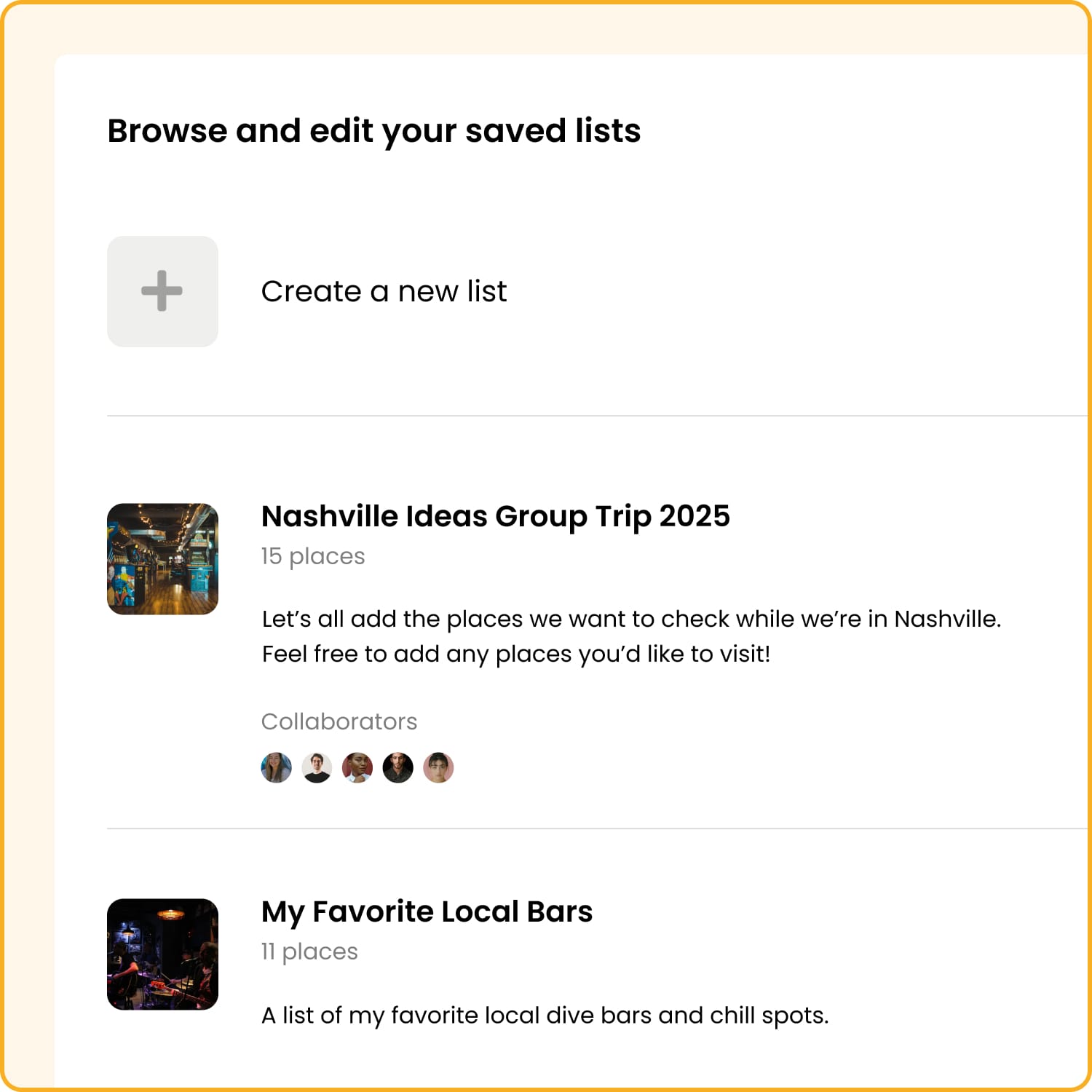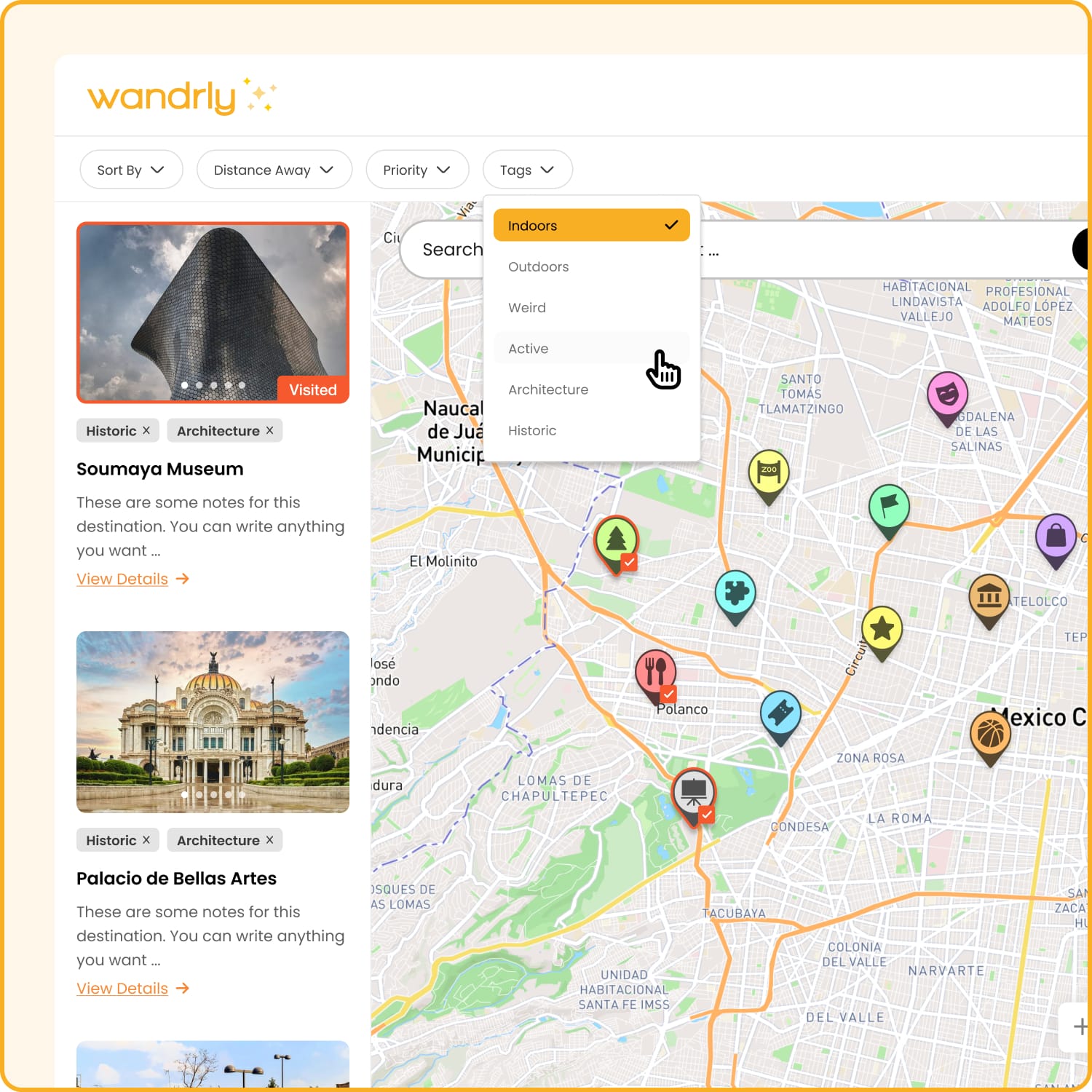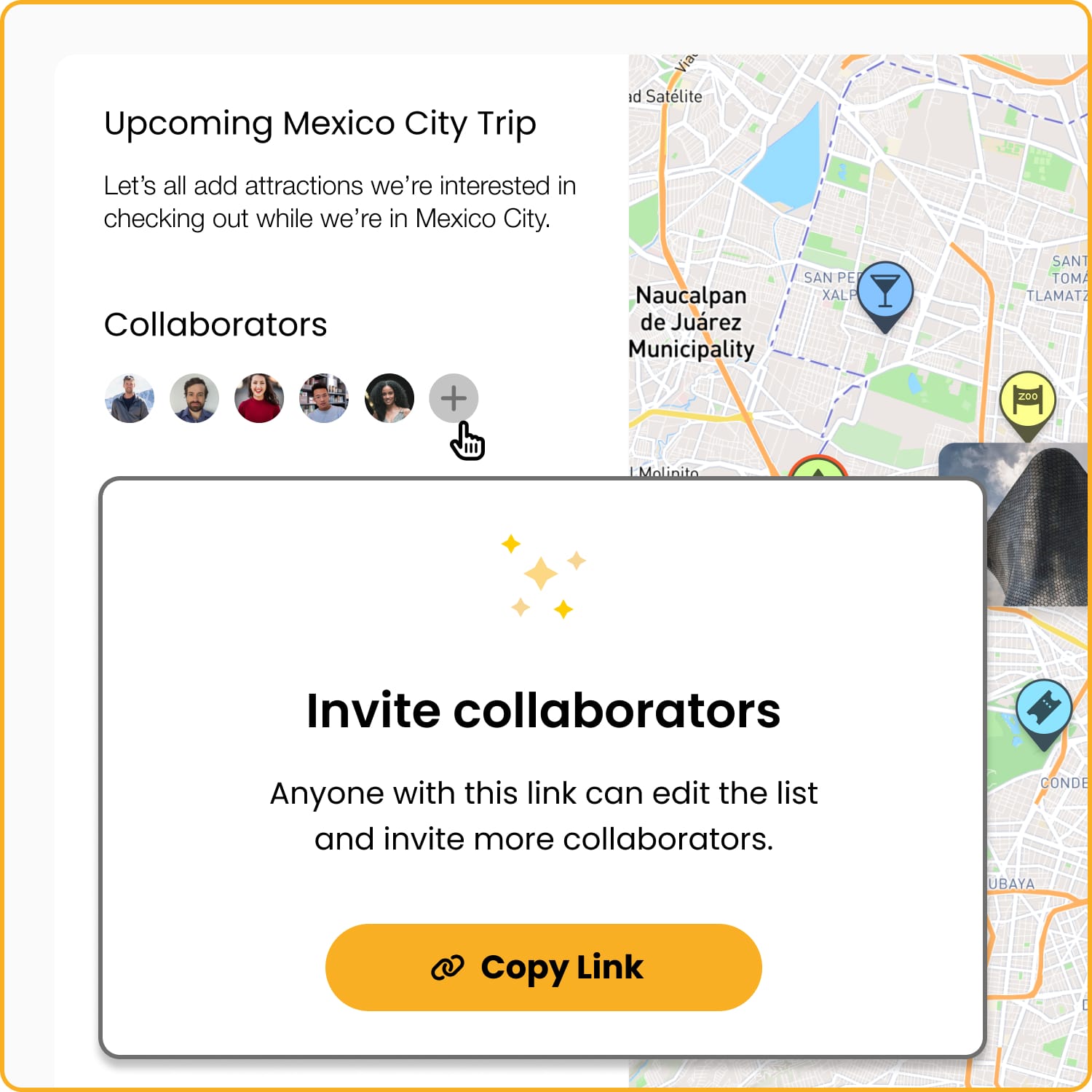Navigating new cities and remembering great spots is challenging, but Google Maps has a powerful feature that solves this problem. Google Maps Saved Places lets you bookmark locations, organize them into lists, and access them anytime.
In this guide, we'll explain what Google Maps Saved Places is, walk through how to use it effectively, discuss its limitations, and introduce you to Wandrly — a powerful alternative that addresses many of Google Maps' shortcomings.
What Are Google Maps Saved Places?
Google Maps isn’t just for directions anymore. The Saved Places feature transforms the app into a versatile tool for organizing your favorite spots and future visits. At aa glance, you can:
- Quickly save locations you love or want to visit later
- Group your saved places into lists such as “Coffee Shops,” “Must-See Attractions,” or “Weekend Escapes”
- Sync saved places across devices (as long as you're signed in to your Google account)
- Access your saved locations even when you’re offline or in airplane mode.
When Should You Consider Using Google Maps Saved Places?
Despite its utility, many travelers overlook Google Maps Saved Places. Let's take a closer look at why Saved Places deserves a permanent spot in your travel toolkit and how it can elevate your exploration experience.
1. Never forget a great location
Saved Places allow you to bookmark any location on Google Maps so you can easily find these locations again later. This solves the common problem of forgetting the name or exact location of places you've visited or want to visit.
For example, if you discover a great restaurant while traveling, you can save it to your "Favorite Restaurants" list with just a few taps.
2. Create custom lists for better organization
Custom lists help you categorize saved places based on your preferences. You can create different lists for restaurants, attractions, shopping spots, or any other category that makes sense for your needs.
For instance, you might create separate lists for "NYC Restaurants," "NYC Museums," and "NYC Shopping" when planning a trip to New York City. Creating multiple lists keeps your saved places organized and makes it easier to find specific types of places when you need them.
3. Access your saved places across all devices
Cross-device synchronization means your saved places are available on any device where you're signed into your Google account. Save a place on your phone, and it's instantly available on your tablet or computer.
This synchronization happens automatically in the background, so you don't need to manually transfer information between devices.
4. Use saved places even without internet
Offline accessibility is one of the most valuable aspects of Saved Places, especially for international travelers who may not have constant internet access.
When you save a place, Google Maps stores key information like the address, phone number, website, and opening hours. This information remains accessible even when you're offline or in airplane mode.
How To Save Google Maps Saved Places
Before you can take full advantage of Google Maps Saved Places, you need to master the basics of saving and organizing places.
Saving places on desktop
- Open Google Maps in your web browser
- Search for the location you want to save
- Click the location from the search results
- On the sidebar, click on the “Save” button
- Choose an existing list or create a new one
- (Optional) Add a note explaining why the place is worth saving
Adding notes is crucial. Notes help you remember why you saved a place, who recommended it, or any special details about it that might be important later.
Saving places on mobile
- Open the Google Maps app
- Search for or tap the place you want to save
- On the location's info card, tap “Save”
- Select a list or create a new one, and add a note if necessary
Saving a location that's not on Google Maps
Sometimes you might want to save a location that doesn't have a listing on Google Maps. Here's how:
- Navigate to the approximate location on the map
- Press and hold to drop a pin at that location
- Tap the pin to open its information
- Tap "Save" to add it to one of your lists
This technique is useful for marking meeting points, scenic viewpoints, or other locations that don't have official listings.
Sharing your lists with others
One of the great features of Saved Places is the ability to share your lists with friends and family:
- Go to the "Saved" tab in Google Maps
- Select the list you want to share
- Tap the three dots menu (...)
- Select "Share list"
- Choose how you want to share (text, email, social media, etc.)
- Send the link to your friends
When you share a list, recipients can view all the places you've saved, along with any notes you've added. This makes it easy to share recommendations or collaborate on trip planning.
Best Practices For Google Maps Saved Places
To get the most out of this feature, follow these proven strategies from experienced users.
Save places liberally
When in doubt, save it. Any time you come across a place that seems interesting, whether recommended by a friend, seen on social media, or spotted while walking around, add it to your saved places.
Saving a place doesn't commit you to visiting it; it simply ensures you won't forget about it. Your future self will thank you for having options readily available.
Always add detailed notes
When saving a place, take a moment to add notes that will help your future self remember:
- Why you saved this place
- Who recommended it to you
- Any specific menu items, features, or details worth remembering
- Best times to visit or things to be aware of
Without notes, you might end up with dozens of saved restaurants with no recollection of why you saved them or what makes them special. For instance, instead of just saving "Joe's Pizza," add a note like "Recommended by Sarah, known for thin crust pepperoni, busy at lunch but quieter after 2pm."
Create a logical naming system
As your collection of lists grows, having a consistent naming convention becomes important. Consider using a format like:
[Location] + [Category] + [Status]
For example:
- "NYC Restaurants Want to Go"
- "NYC Restaurants Visited"
- "London Museums Want to Go"
- "London Museums Visited"
This naming system makes it easy to find the right list when you have dozens of them across multiple destinations.
Use default lists strategically
Google Maps provides three default lists — Favorites, Want to Go, and Starred Places — that have special icons on the map. Use these thoughtfully:
- Favorites: Reserve for truly exceptional places you'd recommend to others
- Want to Go: Use for high-priority places you definitely plan to visit soon
- Starred Places: Best for temporary bookmarks or places you need to find quickly
These default lists are most useful when used sparingly, as their special icons can help these places stand out on your map.
Manage list visibility
As you create more lists, your map can become cluttered with icons. Manage which lists are visible on your map:
- Go to the "Saved" tab
- Tap the three dots (...) next to any list
- Toggle "Show on your map" on or off
This allows you to focus on just the lists relevant to your current needs, reducing visual clutter on the map.
Limitations Of Google Maps Saved Places
While Saved Places is incredibly useful, it does have some notable limitations you should be aware of.
Desktop experience is subpar
The desktop version of Google Maps doesn't handle Saved Places as well as the mobile app. The interface is less intuitive, and changes made on desktop sometimes don't sync properly with the mobile app.
For the best experience, stick to managing your saved places primarily through the mobile app, or use the Google Collections page (www.google.com/save/) for bulk management of saved places.
Can't access saved places when planning routes
One frustrating limitation is that when you're using the directions feature to plan a route, you can't easily access your saved places as destinations. You'll need to remember the names of places you've saved or switch back and forth between screens.
This makes it difficult to plan an efficient route between multiple saved locations, which would be a natural use case for this feature.
Sharing functionality has bugs
Many users report issues when sharing lists with friends. Sometimes shared lists don't show all locations, or changes made to shared lists don't update properly for all users.
These syncing issues can be frustrating when trying to collaborate on trip planning with others, as you can't be certain everyone is seeing the same information.
No way to mark places as visited
Google Maps doesn't provide a built-in way to mark places as "visited" once you've been there. The workaround is to maintain separate "want to go" and "been to" lists, and manually move places between them.
Unfortunately, when you remove a place from one list to add it to another, any notes you've added are deleted, forcing you to rewrite them.
Limited filtering and sorting options
There are very few options for filtering or sorting your saved places. You can't easily filter places by type, rating, or other criteria. The only sort options are by date added and distance.
This becomes increasingly problematic as your lists grow larger, making it difficult to find specific places among dozens or hundreds of saved locations.
Wandrly: A Better Alternative To Google Maps Saved Places
While Google Maps Saved Places is useful, Wandrly offers a more powerful solution specifically designed for travelers and place organization.
Create unlimited custom lists

Like Google Maps, Wandrly allows you to create as many lists as you need. However, Wandrly's list management is more intuitive and flexible, making it easier to organize places by trip, category, or any other system that works for you.
You can create lists for different trips, different categories within a trip, or even collaborative lists for group travel planning — all with a cleaner, more user-friendly interface than Google Maps.
Advanced filtering and sorting
One of Wandrly's biggest advantages is its robust filtering and sorting capabilities, which Google Maps lacks entirely.
With Wandrly, you can:
- Sort places by date added (newest or oldest first)
- Sort alphabetically (A-Z or Z-A)
- Sort by distance from your current location
- Filter by custom tags you've created
- Filter by interest level (how excited you are to visit)
- Filter by visited status
This makes it much easier to find exactly what you're looking for, especially when dealing with large lists of saved places.
Custom tagging system

Wandrly's tagging system enables you to add multiple custom tags to each saved place, then filter by those tags later.
For example, you could tag restaurants as "Breakfast," "Lunch," "Dinner," "Cheap," "Splurge," "Outdoor Seating," etc. Then, when you're looking for a place to eat, you can filter to show only "Dinner" places with "Outdoor Seating."
This level of organization is simply not possible with Google Maps' basic list structure.
Mark places as visited
Unlike Google Maps, Wandrly allows you to mark places as visited without losing any information or having to move them between lists.
This feature makes it easy to keep track of where you've been while maintaining all your notes and organization. You can also filter to show only visited places or only places you haven't visited yet. For travelers who like to keep a record of their experiences, this is a significant advantage over Google Maps.
Collaborative features

While Google Maps does allow list sharing, Wandrly takes collaboration to the next level with:
- Real-time updates for all collaborators
- Notifications when collaborators add or modify places
- The ability to see who added each place to a list
- Comments and discussions about specific places
These features make Wandrly ideal for group trip planning, where multiple people need to coordinate and discuss potential places to visit.
Conclusion: Choose A More Powerful Trip Planner
Google Maps Saved Places is a powerful feature that can transform how you organize and remember locations. By creating custom lists, adding detailed notes, and following best practices, you can build a personalized database of places that enhances your travel experiences and daily life.
However, the limitations of Google Maps — particularly its lack of filtering options, inability to mark places as visited, and occasional syncing issues — can become frustrating as your collection of saved places grows.
For casual users who just need to remember a few locations, Google Maps Saved Places works well enough. But for serious travelers, foodies, or anyone who regularly saves lots of places, Wandrly offers a more robust solution with advanced organization, filtering, and collaboration features.
Whichever tool you choose, the important thing is to start saving places systematically. Your future self will thank you when you're able to instantly find that perfect restaurant, scenic viewpoint, or hidden gem that you might otherwise have forgotten entirely.






